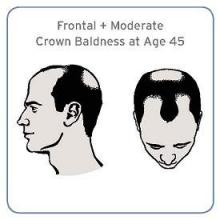Men with a combination of frontal and moderate vertex baldness at age 45 were at a significantly increased risk of having aggressive prostate cancer in a large prospective cohort study, according to investigators.
“Although the effect is moderate, it supports the possibility of overlapping pathogenesis between male pattern baldness and prostate cancer,” Cindy Ke Zhou of the National Cancer Institute, Bethesda, Md., and her associates wrote in their analysis (Sept. 15, J. Clin. Onc. 2014 Sept. 15 [doi: 10.1200/JCO.2014.55.4279])
The results of previous studies evaluating the association between male pattern baldness and prostate cancer – mostly small cross-sectional or case-control studies – have been inconsistent. Unlike those studies, this study looked at subtypes of prostate cancer among 39,070 mostly white men enrolled at aged 55-74 in a large prospective cohort cancer screening study, who had not been diagnosed with cancer. About half reported being bald at age 45.
Over a median of almost 3 years, 1,138 prostate cancers were diagnosed, including 571 that were aggressive. There was no significant association between having frontal plus moderate vertex baldness (affecting both the front and the crown of the head) at age 45 years and prostate cancer overall (hazard ratio, 1.19) or with prostate cancer that was not aggressive (HR, 0.97), when compared with men who were not bald at that age.
However, compared with men who were not bald, this particular pattern of male baldness was associated with a nearly 40% increased risk of aggressive prostate cancer (HR, 1.39), which was statistically significant. There was no association with an increased risk for overall or any subtype of prostate cancer and other hair loss patterns.
“While our data show a strong possibility for a link between the development of baldness and aggressive prostate cancer, it’s too soon to apply these findings to patient care,” the study’s senior author, Michael Cook, Ph.D., of the NCI’s Division of Cancer Epidemiology and Genetics, said in a statement issued by the American Society of Clinical Oncology, the publisher of the journal. But if the results are confirmed, he added, baldness may be a possible way to help identify men who could be at an increased risk of having aggressive prostate cancer.
The study was funded by the NCI’s intramural program of the Division of Cancer Epidemiology and Genetics. None of the authors had disclosures.


